The Vietnam Museum of Ethnology is a convergence of cultures and a scientific ethnological center. It has actively contributed to the conservation and development of the national culture, as well as the cultural traditions and identities of the Vietnamese nationalities.
The museum is located on Nguyen Van Thuyen Street (named after a famous national ethnologist), in Cau Giay District, about 7-8 km from downtown Hanoi. It covers an area of nearly 3.3 hectares. Ha Duc Linh, an architect of the Tay ethnic group, designed the museum in the form of the ancient drum of the Dong Son Culture, and interior decorations were designed by French architect, Veronique Dollfus.
Being part of the National Centre for Social Sciences and Humanities, the Vietnam Museum of Ethnology is involved in various undertakings. It carries out scientific research on Vietnamese nationalities, collects, classifies, assesses, preserves, restores, exhibits, introduces and exploits the cultural and historical values of all the nationalities. It also provides ethnological references and trains staff in the specific fields of the ethnographic museum. The Museum also attaches attention to the cultures of other countries in Southeast Asia, seeing them as potential targets for exhibitions at the museum in the near future.
Since its foundation, the Museum has preserved rich and diverse showpieces and documentary references. At present, more than 15,000 objects, about 40,000 photographs and many audio-visual tapes, of which many collections are of highly cultural value, are exhibited and preserved by the Museum.
At present, the museum comprises two main quarters: the inside and outside display.
Most of the space of the 2-storey building is reserved for long-term and regular display of objects and documents about the cultural characteristics and the out-look of the Vietnamese communities. The showpieces are displayed according to geographical locations and languages, into nine groups which closely link to one another.
They are General introduction – The Viet (Kinh) – Vietnam’s majority group – The Viet – Muong (Muong, Tho and Chut) – The Thai-Kadai, including 8 groups of the Tay-Thai (Tay, Thai, Nung, San Chay, Giay, Bo Y, Lao, and Lu) and 4 groups of the Kadai (La Chi, Co Lao, Pu Peo, La Ha) – The H’mong-Dao (H’mong, Dao, Pa Then), the Tibeto-Burmese (Lo Lo, Ha Nhi, La Hu, Phu La, Si La and Cong), and the Sino-Tibetan (San Diu and Ngai) – The Mon-Khmers of the North (Khmu, Khang, Mang, Odu and Sinh Mun) and of the Truong Son Range and the Central Highlands (Ba-na, Brau, Bru-Van Kieu, Choro, Co, Co Ho, Co Tu, Gie-trieng, Hre, Ma, Mnong, Ro Mam, Ta Oi, Se Dang and Stieng)-The Austronesians of the mountainous regions (Chu Ru, Ede, Gia Rai, Raglai) – The Cham, Khmer and Hoa – Inter-changes among different groups, expressed through highland markets.
In these 9 compartments, about 650 objects are displayed in 100 showcases, large and small, with captions about the name, the place and producer of the object. There are 33 panels with more than 50 articles and nearly 300 photographs introducing the groups’ cultural characteristics. In addition, there are showcases about some other unique cultural identity or custom, such as non (palm-leaf conical hat) making in Chuong Village, funeral rituals of the Muong, buffalo-stabbing ceremony of the Ba-na, then (praying heaven for luck), etc. which are illustrated by video films.
Inside the museum, there are short-term exhibitions. For instance, the “Cultural Resemblance” (through the folk decorative art of the Tay-Thai and Austronesians), opened on the occasion of the 6th ASEAN Summit held in Hanoi in December 1998; the “Chidren’s Mid-Autumn Festival – In the Past and At Present”, opened at the Mid-Autumn Festival of 1999.
The ouutside quater of the display will be completed one section at a time. Traditional architectures typical of each location nationwide are imitated at the museum. They include the burial ground of the Gia-rai, the houses built with po-mu timber of the H’mong, the stilt-house of the Tay, the mixed stilt-and-ground house of the Dao, the traditionally-shaped house of the Viet, the long stilt-house of the matriarchal E-de, the no-wall house of the Ha Nhi, the long house of the Ba-na, etc. At each example, there are captions about the material, tools and techniques with which the original ethnic builders were invited by the museum to build the house. The ethnic builders also participated in introducing information about their products and the cultural traditions of their group. Each house looks like a mini-museum. Through the interior decoration and illustrated information, the visitors can understand the life of each ethnic group.
In both inside and outside quarters, the showpieces are displayed and preserved in their original appearance. The explanations are in Vietnamese, English and French, that is very convenient for visitors.
Among diverse presentations to the public, folk art performances and on-the-spot making of the traditional handicraft articles attract a great number of visitors. In September, the performance “Singing Cheo operetta” organized by the Viet people in Tan Hoi Village, Dan Phuong District, Ha Tay Province, will open for a series of shows at the Museum.
Besides exhibiting, the Museum compiled books, such as a catalogue about the Museum published in 1997, Pictures of Vietnamese Nationalities (1997), The Great Family of Vietnamese Nationalities (1998), Ancient Designs of Dac Lac (1999), Research Projects by the Vietnam Museum of Ethnology, Volume 1 (1999), to name but a few.






